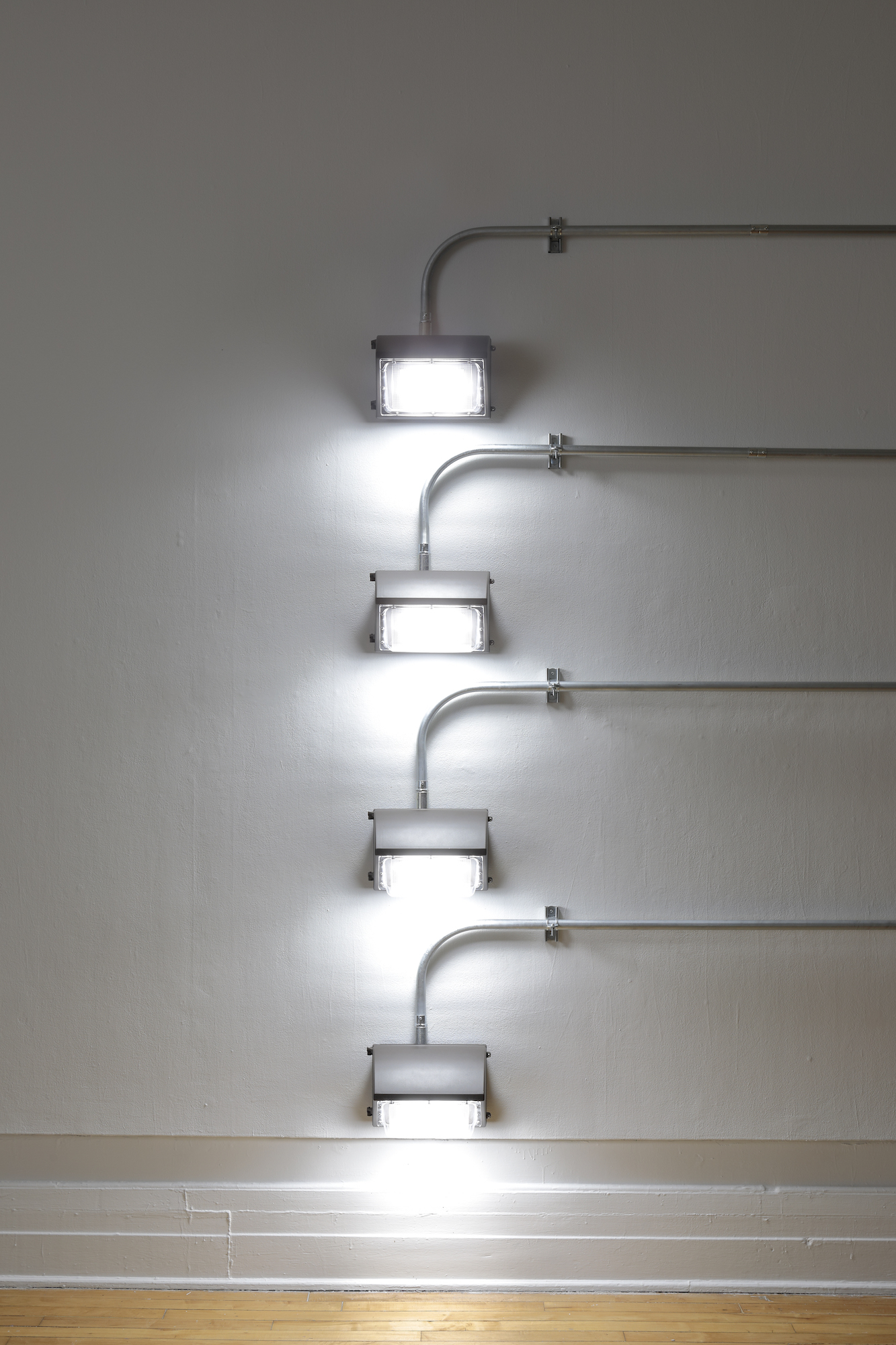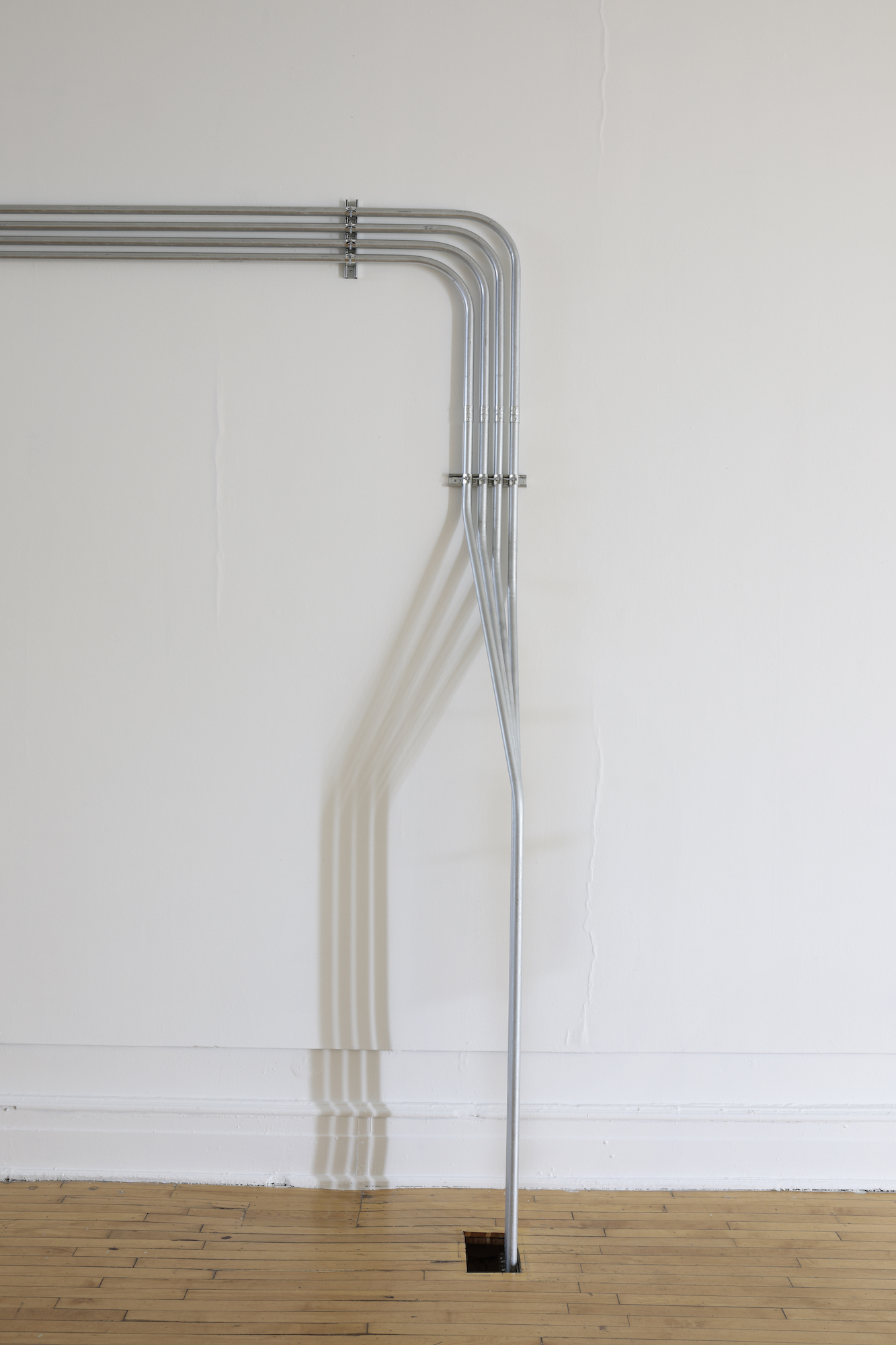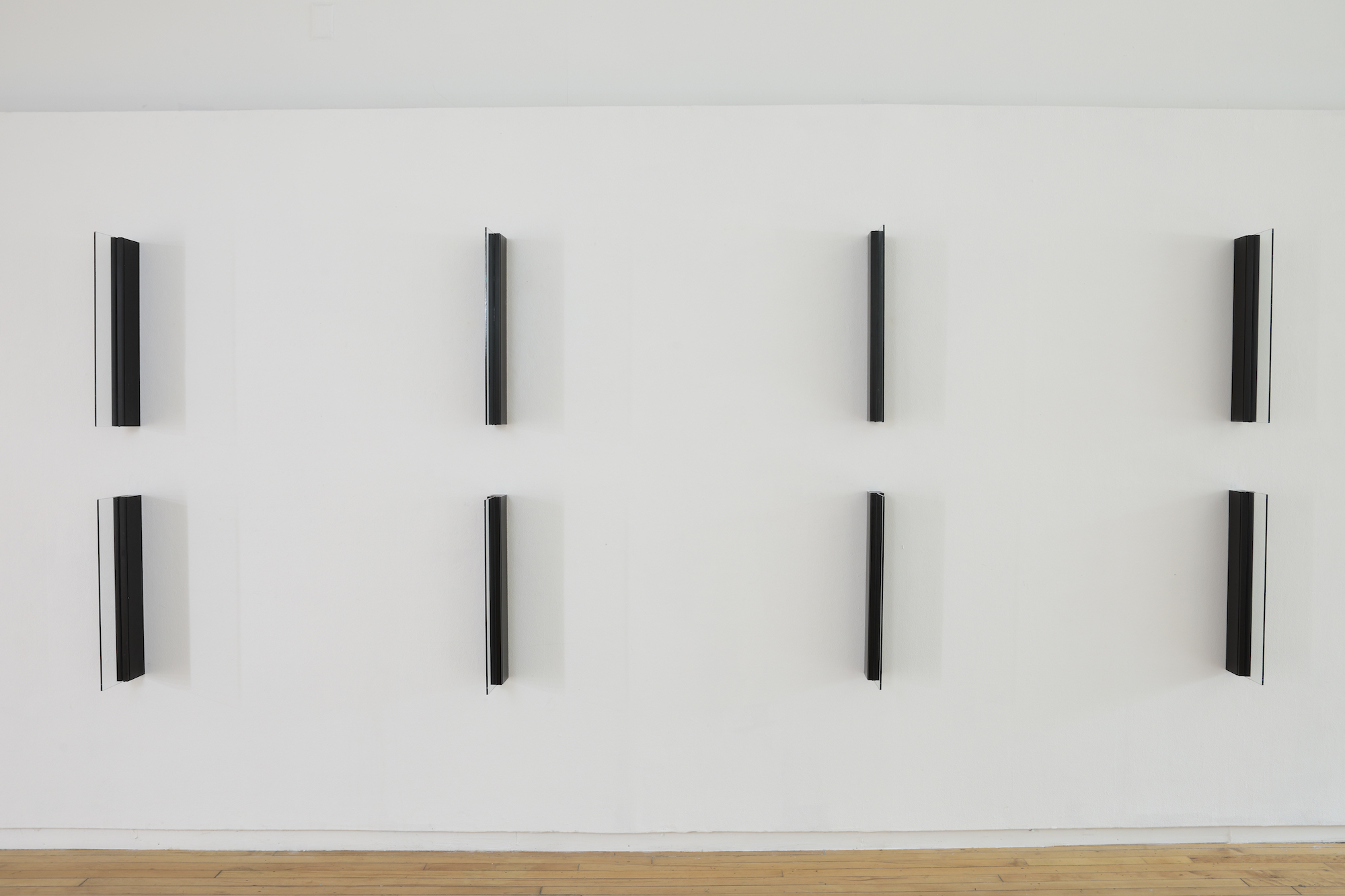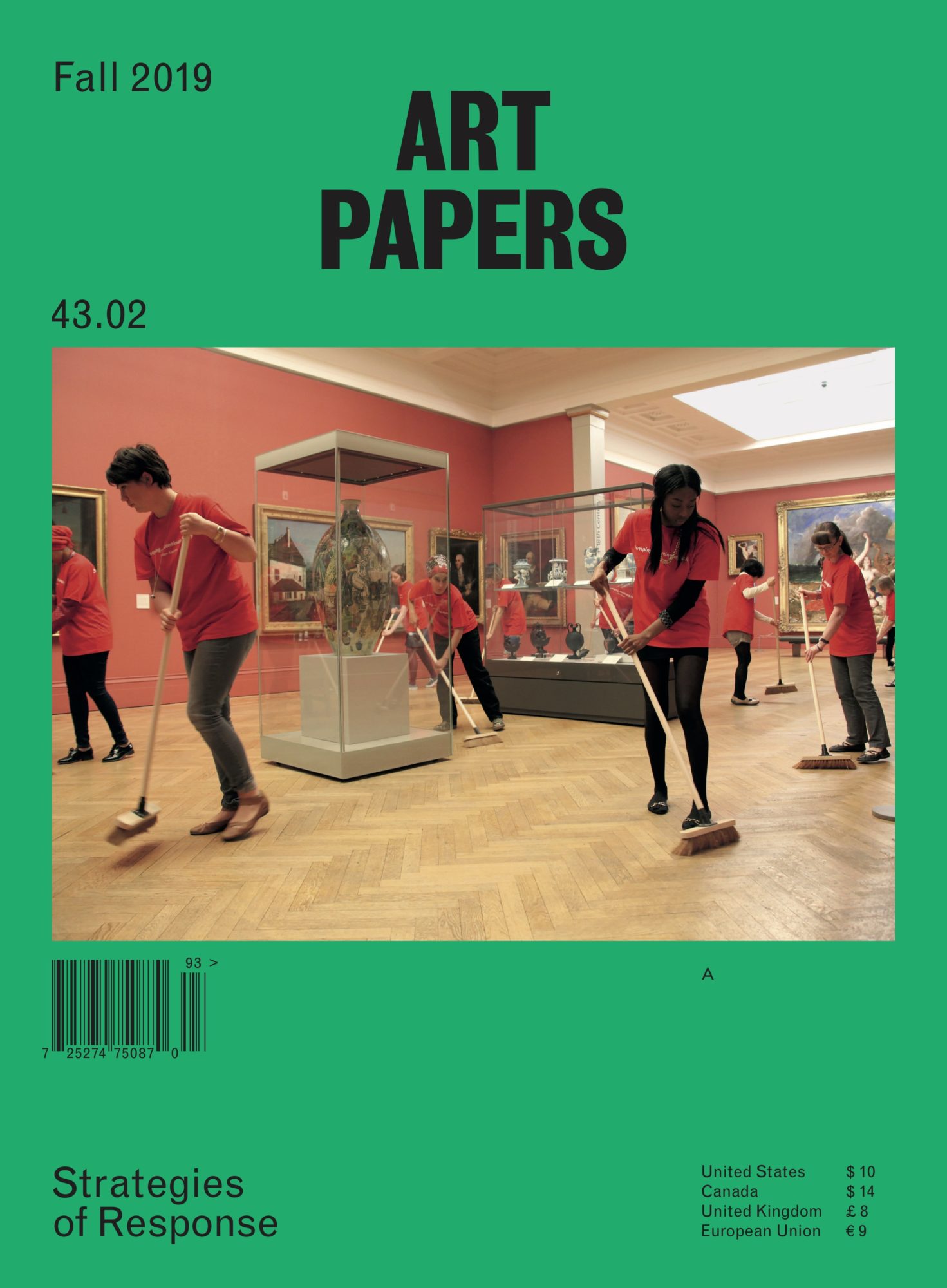Alan Ruiz: Infrapolitics
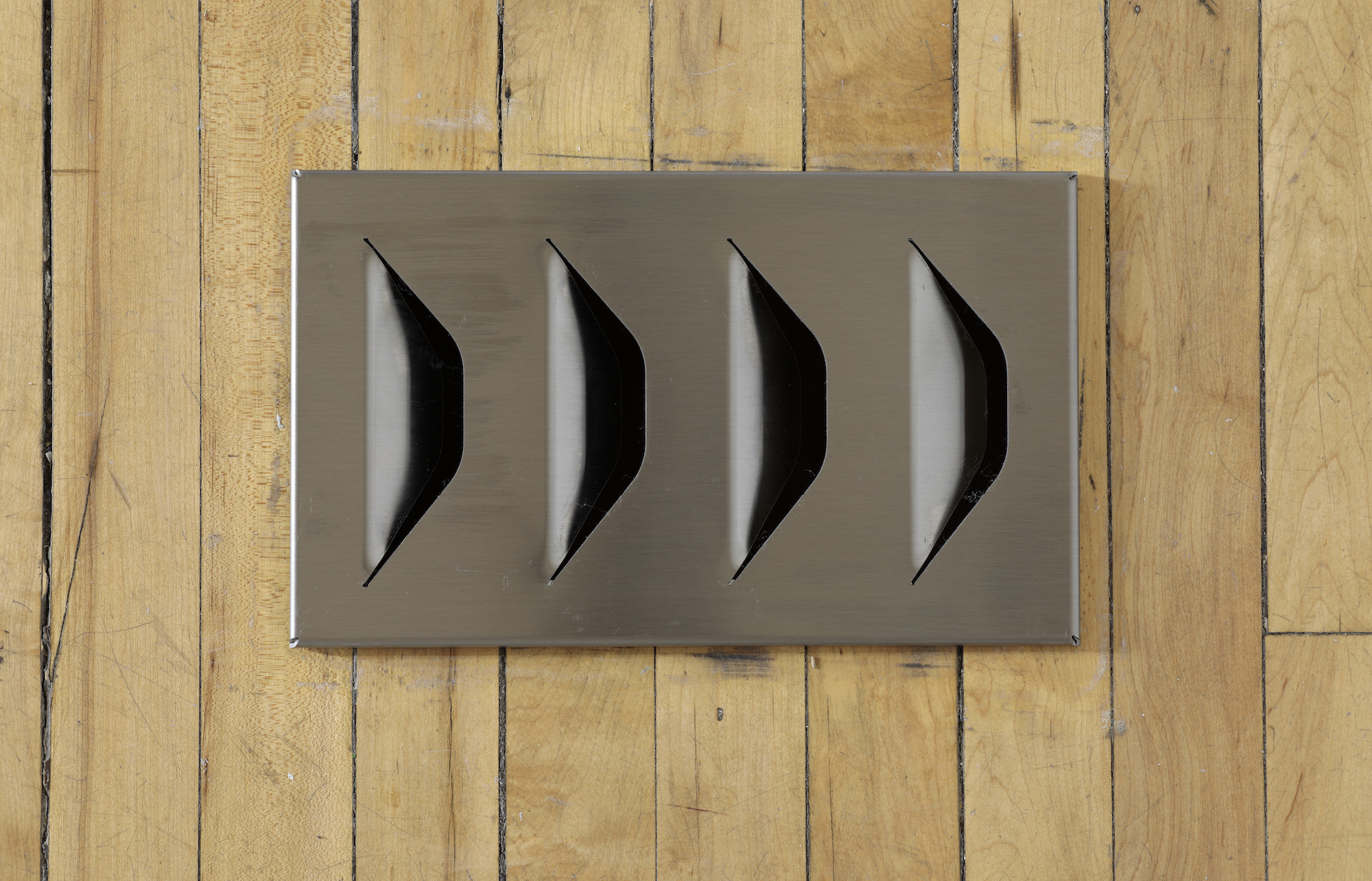
Alan Ruiz, WS-LV1-4, 2019, stainless steel, existing architecture, 11.75 x 10.5 inches [photo: David Hale; courtesy of the artist and 1708 Gallery, Richmond]
Share:
Infrastructure is where the material and political forces shaping our experience most intimately coincide. It is the fabric of the built environment, from network cables to global shipping lanes, electrical grids to satellite orbits. It is also the wider set of political, social, and legal networks that control, sort, and standardize how we move through the world. In his exhibition Infrapolitics, at 1708 Gallery, Alan Ruiz transformed the physical and institutional infrastructures of the gallery to call attention to the collusion of the material and the political in art, as in society broadly.
Three sculptural interventions in metal, glass, and electricity formed the bulk of the installation, all titled with different iterations of “western standards.” On the floor, Ruiz replaced some of the gallery’s floor vents with a series of stylized vent-like sculptures (Western Standards-LV 1–4), drawing attention to the air ducts and storage basement below. On the wall, a sculptural series arranged in two gridded groupings referenced materials used in commercial construction (Western Standards [Enclosures 1–12]). The central work, however, was Western Standards K80X4, in which Ruiz rerouted electrical conduits from the basement into the gallery space itself. Emerging from an open floor vent on the western edge of the room, the silver conduits twisted up and over to meet the wall before wrapping around the gallery toward the east, where they terminated in four large, LED safety lamps. The effect when standing at the center of the room was a sensation of electrical enclosure, of currents whizzing around in an embrace to light the gallery. With all other lights in the room turned off, this system provided a functional service while also bracketing and drawing attention to the infrastructure needed to move electricity.
Alan Ruiz, WS-K80X4, 2019, electrical conduits connected to buildings power supply, 4 LED lamps, existing architecture, dimensions variable [photo: David Hale; courtesy of the artist and 1708 Gallery, Richmond]
Alan Ruiz, WS-K80X4, 2019, electrical conduits connected to buildings power supply, 4 LED lamps, existing architecture, dimensions variable [photo: David Hale; courtesy of the artist and 1708 Gallery, Richmond]
It’s easy to take lamps for granted. Along with highways, the mail service, grocery stores, and tap water, virtually every moment we live is supported by systems of infrastructure. We typically become aware of these systems and the impact of their material realities only when they break, whether because of environmental catastrophe, government shutdown, or economic collapse. Martin Heidegger identified this shift as “ready-to-hand” versus “present-to-hand”—when an object or system breaks, it transforms from being something we use without noticing to something that we actively recognize as real and present.
Significantly, Ruiz did not break the gallery’s electrical system to make it visible. Instead, he took control of the given infrastructure by rerouting it to new ends. The choice to engage with the system and transform it, rather than destroying or withdrawing from it entirely, is one of the primary subtexts underlying Infrapolitics and Ruiz’s practice as a whole. In a 2016 essay titled “Radical Formalism,” Ruiz argues for the continued relevance of form and materiality in politically motivated artistic practice. Drawing on the work of political theorist Chantal Mouffe, he asserts that formalism—despite its associations with purity and apolitical indifference—can be politically activated through a détournement of its traditional ideology. “Put simply,” Ruiz writes, “it’s not just a question of what the work looks like, but what is the work doing?” In the case of Infrapolitics, the act of rerouting the gallery’s electrical power and resignifying commercial materials produced a metaphorical détournement of institutional power.
Ruiz’s intervention functioned primarily as a metaphor, which was made evident by the multiple institutional infrastructures his project addressed. Three small reproductions of archival photographs, hung at the front of the gallery, documented plans for the Richmond-Petersburg Turnpike. Begun in 1955, the construction of this highway coincided with the federal “urban renewal” program of the 1950s, in which US city governments razed poor neighborhoods to build highways and other amenities to attract wealthier (and whiter) businesses and families to city centers. The effect was the almost total destruction of communities of color across the United States. The Richmond-Petersburg Turnpike followed the model, dividing and crippling the city’s oldest African American neighborhood of Jackson Ward.
Alan Ruiz, WS-E1-8, 2019, aluminum, hardware, glass, rubber, each unit 8.5 x 1.75 x 24 inches/dimensions variable [photo: David Hale; courtesy of the artist and 1708 Gallery, Richmond]
Today, the spirit of urban renewal lives on in the neoliberalized form of gentrification. Jackson Ward continues to be threatened by the slow encroachment of Virginia Commonwealth University—most recently underscored by the opening of the Institute of Contemporary Art at the neighborhood’s southwestern corner. Not surprisingly, the neighborhood’s southern border is also home to the majority of Richmond’s art galleries, including 1708. By calling attention to the historical destruction of the community at the invisible hands of urban renewal, Ruiz expanded his critique to include the economic infrastructure of the art world and its continued complicity in gentrification.
Returning to his call for intervention over negation as a means to enact critical change, the most significant (and functional) element of Ruiz’s project was his requirement that 1708 become W.A.G.E. certified. A nonprofit organization founded in 2008, W.A.G.E. (Working Artists and the Greater Economy) provides tools to educate and collectivize artists in support of fair and sustainable compensation for their labor, such as an artist fee calculator and a national accreditation program for institutions. As with his sculptural installation, Ruiz’s intervention into the economic infrastructure of the gallery transforms 1708’s relationship to the Richmond community (specifically, the Richmond art community). The gallery is now the first and only W.A.G.E.–accredited institution in Richmond—a powerful precedent that other institutions in the city ideally will soon follow.
This review originally appeared in ART PAPERS Fall 2019 “Strategies of Response,” and was incorrectly credited to Claire Phillips, rather than its author Allison Myers. We apologize for the error.
Allison Myers is a writer and curator currently based in Richmond, VA, where she is Visiting Assistant Professor of art history at the University of Richmond. Her research focuses on issues of immigration, cultural translation, and stereotypes, especially in France and the United States. Myers is also the founder of Breach Press, a small press dedicated to publishing bilingual translation work and artists’ books.
